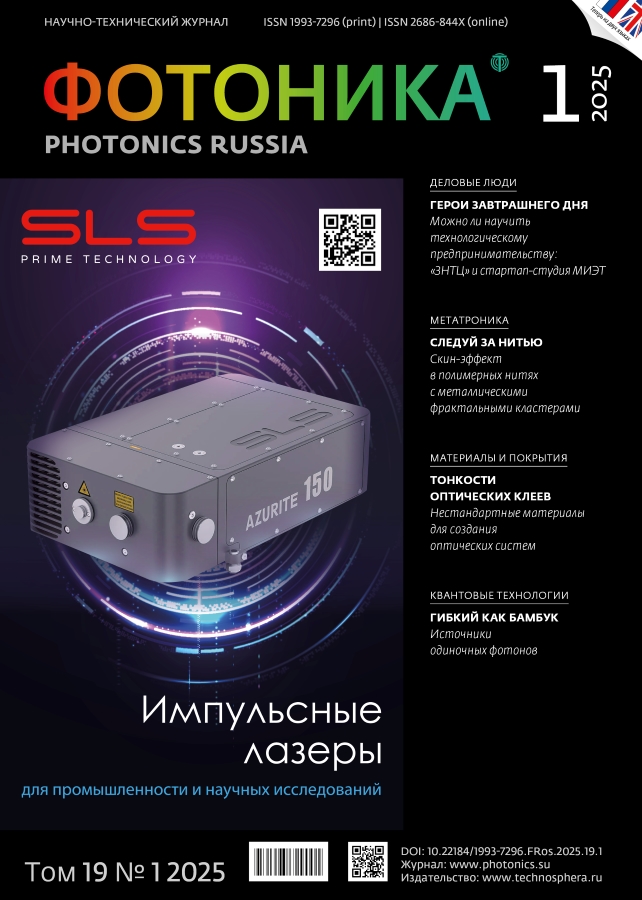Vol 19, No 1 (2025)
- Year: 2025
- Articles: 6
- URL: https://journals.eco-vector.com/1993-7296/issue/view/13016
- DOI: https://doi.org/10.22184/1993-7296.FRos.2025.19.1
Business people
Our business philosophy is to think ahead
Abstract
JSC ZNTC, one of the technological leaders of the Russian microelectronics market, confidently declares its position in the photonics market. Anatoly Andreevich Kovalev, General Director of ZNTC JSC, graduate of MIET, Doctor of Technical Sciences, spoke about the company’s tasks and the intricacies of technological solutions.
 8-11
8-11


Metatronics
Interaction of electromagnetic radiation with the metal fractal clusters. Part 1
Abstract
This paper provides the results of studies on the influence of the aluminum nanoisland dimensions with a length l during the fractal cluster formation on the polymer threads using the carbon benzene ring fibers on the conditions for the occurrence of “highly conductive off-surface state” during breakdown with an electric field strength of 1.6 kV/cm. The layer thickness was calculated in the case of the skin-effect in polymer threads with the metal fractal clusters for electromagnetic radiation with a wavelength λ and fulfillment of condition l << λ.
 14-27
14-27


Quantum Technologies
Single photon sources. A review. Part 3
Abstract
The article continues the review of single photon sources while considering various methods for the single photon sources (SPS) development. Earlier, the first part of the review (Photonics Russia. 2024; 18(5): 376–396) discussed the requirements for single-photon sources and their characterization criteria, described the single-ion and single-atom-based single-photon sources. The SPSs based on the quantum dots and color centers in the crystals were considered in the second part of the review (Photonics Russia. 2024; 18(8): 610–620). The third part considers the single-photon sources based on the carbon nanotubes and their defects (defect engineering in the nanotubes), on nanocrystals and layered nanocrystals.
 28-38
28-38


Materials and Coatings
Non-standard materials for optical system development
Abstract
With the advances in optical technologies, the quality requirements for the optical and technical products are increasing. Therefore, there is a need to develop new optical materials that can improve the parameters and specifications of optical systems, such as transparency, lightness, strength, environmental resistance and cost efficiency. The paper considers some non-conventional optical materials and their practical application.
 40-48
40-48


Analysis of polylactide-based materials by raman spectroscopy
Abstract
We present Raman study of a number of polylactide-based materials: polylactide stereoisomers, L-lactide oligomers, L-lactide/ε-caprolactone copolymers, and poly(L-lactide)/hydroxyapatite composites. It is established that the composition and crystallinity degree of a wide range of polylactide-based materials can be determined by Raman spectra. The advancement of this technique is crucial for the development of innovative polylactide-based materials used both for diverse medical applications and, for example, in the creation of biodegradable disposable packaging to address environmental pollution problems.
 50-60
50-60


Preparation and properties study of IGZO thin films obtained by PECVD method
Abstract
In this paper, the plasma-enhanced chemical vapor deposition (PECVD) method was used for the first time to obtain InGaZnO (IGZO) thin films with various stoichiometry, morphology, and phase composition. The films were synthesized using the setup described in detail in [1–5]. The precursors were elementary high-purity In, Ga, and Zn, the carrier gases were Ar and H2, and a mixture of (Ar-H2-O2) was used as a plasma-forming gas. Deposition was performed on the high-pure quartz glass substrates. The composition of the samples was determined by the energy-dispersive X-ray analysis. The obtained samples were also examined by the scanning electron microscopy (SEM), atomic force microscopy (AFM), and optical profilometry methods. The electrical properties of the obtained films, such as the type, mobility, and carrier concentration, were established by the Hall effect measurements.
 62-70
62-70








